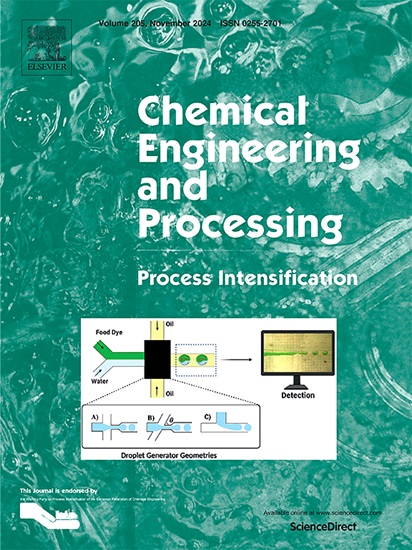在离心微流体平台上使用体声波 (BAW) 操纵细胞/粒子:数学研究
IF 3.8
3区 工程技术
Q3 ENERGY & FUELS
Chemical Engineering and Processing - Process Intensification
Pub Date : 2024-11-01
DOI:10.1016/j.cep.2024.110024
引用次数: 0
摘要
本研究介绍了一种用于聚焦和分离微颗粒的集成声学辅助离心微流控系统。利用离心力和体声(BAWs)同时作用于电动盘上实验室装置(eLOD)的原理,进行了三维数值模拟,分析了微颗粒的运动。因此,我们分析了微颗粒在径向定位的矩形微通道中以不同转速的运动情况。研究了微通道到中心/半径的距离、倾斜角 (α)、超声波振荡幅度、微通道尺寸和粒子直径等物理参数对粒子轨迹和聚焦效率的影响。研究发现,在 α = 30° 时适当调整微通道的位置,可以将聚焦的微颗粒流引向所需的出口。BAW 的振荡幅度越大(0.3 nm),微颗粒就能在 200 微米宽的微通道中以 80 拉德/秒的旋转速度完美地聚焦到中间出口。此外,还模拟了该系统从白细胞中分离循环肿瘤细胞(CTC)的能力。结果表明,只要在 286 转/分的转速下适当调整微通道的位置或倾斜角度,就能成功分离这些生物颗粒。本文章由计算机程序翻译,如有差异,请以英文原文为准。

Cell/particle manipulation using Bulk Acoustic Waves (BAWs) on centrifugal microfluidic platforms: A mathematical study
This study presents an integrated acoustic-aided centrifugal microfluidic system to focus and separate microparticles. A 3D numerical simulation was conducted to analyze microparticle movement by exploiting the simultaneous imposition of centrifugal forces and bulk acoustic waves (BAWs) on an electrified lab-on-a-disc device (eLOD). Accordingly, the movement of microparticles was analyzed in a radially positioned rectangular microchannel at various rotation speeds. The effect of physical parameters, including the distance of the microchannel to the center/radius, tilting angle (α), the oscillation amplitude of BAWs, the microchannel's dimension, and the particles’ diameter on particle trajectories and focusing efficiency, was studied. It was found that properly adjusting the microchannel's placement at α = 30° made it possible to direct the focused stream of microparticles toward the desired outlet. Higher values of applied oscillation amplitude of BAWs (0.3 nm) led to perfect focusing of microparticles toward the middle outlet in a 200-µm width microchannel at 80 rad/s rotation. Furthermore, the system's ability to separate the circulating tumor cells (CTC) from white blood cells (WBC) was also simulated. The results showed that a successful size-based separation of these bioparticles is achievable by adequately adjusting the microchannel's position or tilting angle at 286 rpm.
求助全文
通过发布文献求助,成功后即可免费获取论文全文。
去求助
来源期刊
CiteScore
7.80
自引率
9.30%
发文量
408
审稿时长
49 days
期刊介绍:
Chemical Engineering and Processing: Process Intensification is intended for practicing researchers in industry and academia, working in the field of Process Engineering and related to the subject of Process Intensification.Articles published in the Journal demonstrate how novel discoveries, developments and theories in the field of Process Engineering and in particular Process Intensification may be used for analysis and design of innovative equipment and processing methods with substantially improved sustainability, efficiency and environmental performance.

 求助内容:
求助内容: 应助结果提醒方式:
应助结果提醒方式:


